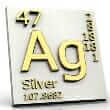Background
- Colloidal silver is a suspension of submicroscopic metallic silver particles in a colloidal base. Long-term use of silver preparations can lead to argyria, a permanent condition in which silver salts deposit in the skin, eyes, and internal organs. The skin can often appear ashen-gray due to the deposition of the silver salts. Argyria has been mistaken for cyanotic heart disease.
- Today, colloidal silver is not generally recognized as safe or effective. However, some researchers believe that it has antibacterial properties, which may warrant further studies. Despite the lack of scientific evidence, colloidal silver is most commonly used as a natural antibiotic or healing agent. It is either applied to the skin or ingested as a drink to promote healing or to combat disease.
- The U.S. Food and Drug Administration (FDA) has taken action against several colloidal drug companies, including Web site advertisers, for making unsubstantiated claims for their product. Colloidal silver products are usually marketed as dietary supplements. Therefore, the manufacturers do not need to go through the same rigorous approval processes as drug companies.
References
- Brentano L, Margraf H, Monafo WW, et al. Antibacterial efficacy of a colloidal silver complex. Surg Forum 1966;17:76-78.
View Abstract - Chang AL, Khosravi V, Egbert B. A case of argyria after colloidal silver ingestion. J Cutan Pathol 2006 Dec;33(12):809-11.
View Abstract - Fujimoto T, Sainoo T, Kamisaka M. [Silver-protein allergy]. Jibiinkoka 1970;42(1):33-36.
View Abstract - Gulbranson SH, Hud JA, Hansen RC. Argyria following the use of dietary supplements containing colloidal silver protein. Cutis 2000;66(5):373-374.
View Abstract - Isenberg S, Apt L, Yoshimuri R. Chemical preparation of the eye in ophthalmic surgery. II. Effectiveness of mild silver protein solution. Arch Ophthalmol 1983;101(5):764-765.
View Abstract - McKenna JK, Hull CM, Zone JJ. Argyria associated with colloidal silver supplementation. Int J Dermatol 2003;42(7):549.
View Abstract - Mirsattari SM, Hammond RR, Sharpe MD, et al. Myoclonic status epilepticus following repeated oral ingestion of colloidal silver. Neurology 2004;62(8):1408-1410.
View Abstract - Okan D, Woo K, Sibbald RG. So what if you are blue? Oral colloidal silver and argyria are out: safe dressings are in. Adv Skin Wound Care 2007;20(6):326-330.
- Parker WA. Argyria and cyanotic heart disease. Am J Hosp Pharm 1977;34(3):287-289.
View Abstract - Spratt DA, Pratten J, Wilson M, et al. An in vitro evaluation of the antimicrobial efficacy of irrigants on biofilms of root canal isolates. Int Endod J 2001;34(4):300-307.
View Abstract - White JM, Powell AM, Brady K, et al. Severe generalized argyria secondary to ingestion of colloidal silver protein. Clin Exp Dermatol 2003;28(3):254-256.
View Abstract







